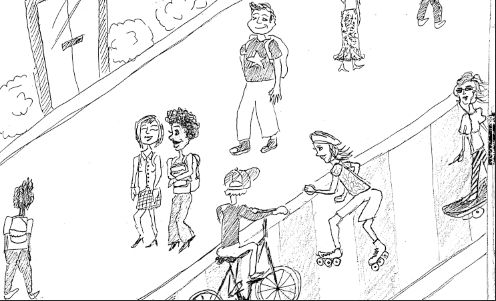
The Personal Safety Committee has proposed changes to the Student Handbook limiting non-motor vehicle transportation on campus between the Fine Arts Building and Jacobsen Faculty Tower. The proposed limitations would apply to skateboarding, roller skating, roller blading and cycling.
Modes of non-motor based transportation have always been used frequently by the student body, but we at The New Paltz Oracle believe more can be done to help both the riders and pedestrians coexist peacefully.
The Student Association held forums on campus earlier this week to address any concerns regarding the proposed changes. Many students, particularly skateboarders, strongly disagreed with the limitations since they frequently use these means of transportation to get from their dormitories across campus to class.
However, given the concentration of foot traffic on the academic concourse, leaving the dorms a couple minutes earlier and walking the skateboard or bicycle to class is not the end of the world and would improve overall pedestrian safety.
While we agree that using these modes of transportation makes students lives a lot easier, convenience is not the only factor that needs to be considered. The academic concourse is a shared space between pedestrians and those using non-motor vehicle transportation.
The proposed changes would only prevent people from riding their skateboards or bikes between the hours of 8 a.m. to 6 p.m. Monday through Friday. During these hours, the concourse by Coykendall Science Building and the Lecture Center/Humanities is highly concentrated with students en route to their classes. The proposed changes would increase safety for the crowd of pedestrians while still providing ample time to use this area for skating during the evenings and weekends as the weather begins to warm up.
At the forum, an individual suggested New Paltz invest in constructing a skate park on campus. While we doubt that the construction of an entire skate park is feasible, we do agree that compromise is possible. Perhaps a space on campus with less foot traffic, such as areas by the athletic fields behind Ridgeview Hall or near Lenape and Esopus Halls, could be good places for these activities.
Designating such an area would provide a space for skaters to exercise freely with their friends while avoiding conflict with pedestrians trying to get from point A to point B as per their academic obligations. This would both increase pedestrian safety and provide skaters with more real estate in which to hone their skills.
It is important to note that these proposed changes are not set in stone; these forums were held to gauge and address students’ concerns. Upon hearing the proposed changes and the students’ rebuttals, we believe a potential solution would be to designate bicycle and skateboarding lanes that would allow users of non-motor vehicles to stay in a controlled lane separate from the pedestrian pathway.
Designating such pathways would allow pedestrians to have their own space and for those using such methods of transportation to move more freely. The two groups could easily avoid each other in their commute to class, thus mitigating the chance of injury and accommodating both populations.
We acknowledge that a lot of outrage among skaters particularly stems from the proposed change prohibiting them to bust tricks on the rocks on the concourse by the Lecture Center. However, related injuries have occured in this area specifically and we believe it is necessary to put regulations in place.
To reiterate, there is not going to be a ban on skating or cycling on campus completely. The goal of the Personal Safety Committee is simply to improve safety and reduce risk of injury for both pedestrians and users of non-motor vehicle transportation when these areas are highly concentrated.
Limiting riding and skating hours in specific areas such as the concourse, inside the academic buildings and within 20 feet of the buildings is reasonable and beneficial to the safety of everyone on campus. Luckily, the campus has a lot of other open space to take advantage of when in need of a riding fix.
We believe that it is possible to reach a compromise to ensure pedestrian safety and the approval of the riding community, therefore allowing everyone to reach their respective destinations safely and efficiently.
